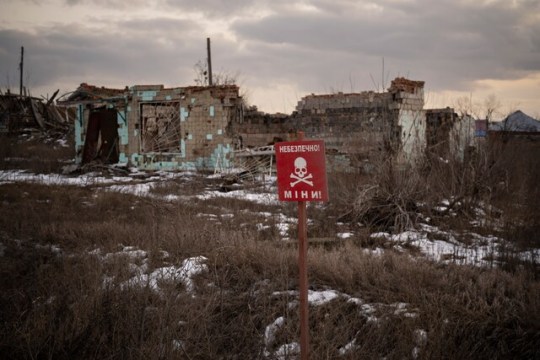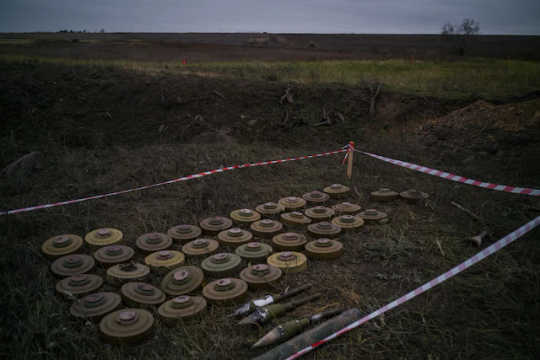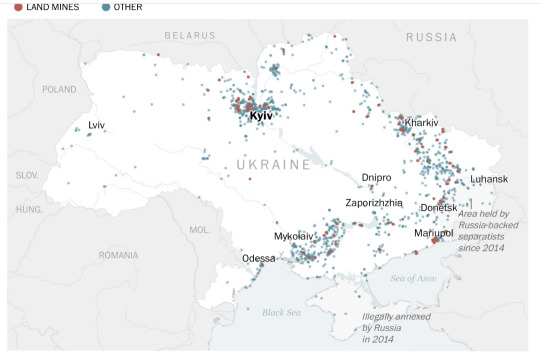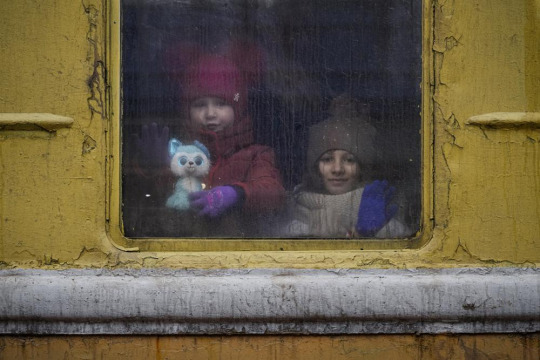#Vadim Ghirda
Text

Romanian bear dancers, Romania, by Vadim Ghirda
#romania#europe#eastern europe#traditional clothing#traditional fashion#folk clothing#cultural clothing#romanian
4K notes
·
View notes
Text

October 24, 2023: A woman takes pictures on a mobile phone as priests walk during procession for Saint Dimitrie Bassarabov, patron saint of the Romanian capital, in Bucharest, Romania. (AP Photo/Vadim Ghirda)
162 notes
·
View notes
Text

A sign warns of mines in the village of Kamyanka, on the outskirts of Izium, Ukraine, on Feb. 19. (Vadim Ghirda/AP)
There is now a huge amount of ordnance contamination in Ukraine and I think this problem is going to continue for a very long time and will have many chaotic negative consequences. Ordnance contamination refers to the presence of unexploded ordnance including mines, shells, rockets, and bombs in current and former war zones. Once hostilities have ceased, these objects, also known as ERW (Explosive Remnants of War) retain their explosive qualities and continue to injure and kill people, and can also leach toxic substances such as lead, mercury, and depleted uranium into the environment.
Anti-personnel mines are particularly deadly. There are some newer types of mine (both anti-personnel and anti-vehicle) that are designed to eventually self-detonate, which would ideally reduce risk to civilians post-war, but these self-detonation systems have significant failure rates, and in cases where the self-detonation system fails, the mine remains active indefinitely. No matter what model of mine is deployed, it always results in ordnance contamination and poses grave danger to civilians.
In 2020, there were 7,073 injuries and deaths due to mines and ERW worldwide. 80% of those casualties were civilians.
But 2020 has passed, and as the Russo-Ukranian war drags on, more and more mines and ERW are being scattered across conflict zones by both Russian and Ukrainian forces.
Articles under the cut.
Here is an article about the recently alleged illegal use of anti-personnel mines by Ukrainian forces:
Evidence mounts for use of banned mines by Ukrainian forces, rights group says
By Eve Sampson and Samuel Granados
June 30, 2023 at 12:00 a.m. EDT
Ukrainian forces appear to have used rockets to scatter stacks of internationally banned, hand-size antipersonnel land mines over Russian-occupied areas in eastern Ukraine, according to evidence collected by Human Rights Watch.
A report released overnight adds to previous evidence collected by the New York-based rights group suggesting that Ukrainian forces scattered thousands of antipersonnel mines last year, injuring civilians, in violation of the 1997 Mine Ban Treaty, to which Ukraine is a signatory. Russia, which has not signed the treaty, has used antipersonnel mines far more extensively, rights groups say.
The bodyweight-triggered mines in question are considered particularly pernicious and violate international laws of war because they harm soldiers and civilians indiscriminately. Their small size and innocuous appearance can lead to children or other civilians handling them unknowingly.
The rights group examined photographs of the remains of rockets found in eastern Ukraine that are used exclusively to scatter PFM-1S antipersonnel mines. Handwritten messages on the remains could be traced back to Ukrainian organizations that offered to have “death wishes” inscribed on various munitions to raise funds for the war effort.
Russian forces have made use of at least 13 different types of banned antipersonnel mines, as well as victim-activated booby traps, in the invasion of Ukraine, Human Rights Watch found in previous reports. But Ukraine has expressly committed not to use them, despite evidence suggesting the contrary.
“These antipersonnel mines have had immediate and devastating consequences for civilians in and around Izium, including by tearing off limbs of residents as they go about their daily lives,” said Ida Sawyer, the director of Human Rights Watch’s crisis and conflict division.
Known as butterfly or petal mines for their shape, small size and light weight, PFM mines are typically green or brown, and one wing is filled with explosives meant to detonate when enough pressure, between 11-55lbs, is applied.
Though some types of PFMs can be emplaced by hand, PFM-1S variant must be deployed using a mine-laying system from a mortar, aircraft or rocket such as the Uragan 9M27K3 mine-laying rocket identified in the report.
Such rockets can carry 312 mines in stacks of “cassettes” that disperse after the rocket is fired.
PFM-1S mines, which can float down to the ground without detonating, are equipped with a mechanism that is designed to self-destruct between 1-40 hours after deployment.
When that mechanism fails, which it often does, the mines threaten civilians by remaining undetonated on the ground indefinitely.
The 1997 Mine Ban Treaty, to which the United States, like Russia, is not a party, requires countries to abstain from using antipersonnel mines and get rid of any stores they may have, a process that can be costly.
Russia’s rejection of the treaty does not exempt it from accountability, Sawyer said, as any use of “inherently indiscriminate weapons” violates international law.
Though Ukraine ratified the treaty in 2005 and officials reported the destruction of millions of antipersonnel mines, in 2021 the country reportedly still possessed more than 3 million.
Any use of mines contributes to an arduous process for returning Ukraine’s land to civilian use. Demining is a slow, costly enterprise that experts say could take as many as hundreds of years.
Since Ukraine regained control of the territory around Izyum, Sawyer said, a new round of mine injuries have been reported. “Because of the nature of these mines,” Sawyer said, “civilians will likely suffer for many years to come.”
Here is an article about Ukraine’s current prognosis with regards to mines and ERW:
Ukraine is now the most mined country. It will take decades to make safe.
By Eve Sampson and Samuel Granados
July 22, 2023 at 3:00 a.m. EDT

Mines and unexploded rockets next to a destroyed bridge on the way to Kherson, Ukraine, in November. (Wojciech Grzedzinski for The Washington Post )
In a year and a half of conflict, land mines — along with unexploded bombs, artillery shells and other deadly byproducts of war — have contaminated a swath of Ukraine roughly the size of Florida or Uruguay. It has become the world’s most mined country.
The transformation of Ukraine’s heartland into patches of wasteland riddled with danger is a long-term calamity on a scale that ordnance experts say has rarely been seen, and that could take hundreds of years and billions of dollars to undo.
Efforts to clear the hazards, known as unexploded ordnance, along with those to measure the full extent of the problem, can only proceed so far given that the conflict is still underway. But data collected by Ukraine’s government and independent humanitarian mine clearance groups tells a stark story.
Ordnance contamination
HALO Trust used open-source information to track more than 2,300 incidents involving ordnance and mines in Ukraine from the start of Russia’s invasion on Feb. 24, 2022, up to July 11, 2023.
“The sheer quantity of ordnance in Ukraine is just unprecedented in the last 30 years. There’s nothing like it,” said Greg Crowther, the director of programs for the Mines Advisory Group, a British charity that works to clear mines and unexploded ordnance internationally.

Staggering scale
About 30 percent of Ukraine, more than 67,000 square miles, has been exposed to severe conflict and will require time-consuming, expensive and dangerous clearance operations, according to a recent report by GLOBSEC, a think tank based in Slovakia.
Though the ongoing combat renders precise surveys impossible, the scale and concentration of ordnance makes Ukraine’s contamination greater than that of other heavily mined countries such as Afghanistan and Syria.
HALO Trust, an international nonprofit that clears land mines, has tracked, using open-source information, more than 2,300 incidents in Ukraine in which ordnance requiring clearance was discovered. Though events are greatly underreported and the data does not include the results of on-the-ground surveys by HALO Trust or other organizations, it gives a harrowing outline of the problem.
This week’s deployment by Ukrainian forces of U.S.-made cluster munitions, which are known to scatter duds that fail to explode, can only add to the danger.
Human cost
The explosives have already taken a heavy toll. Between the start of Russia’s full-scale invasion in February 2022 and July 2023, the United Nations has recorded 298 civilian deaths from explosive remnants of war, 22 of them children, and 632 civilian injuries.

Hidden killers
Both sides use mines. Russia heavily mined its front lines in anticipation of Ukraine’s ongoing counteroffensive, and has made far more extensive use of widely banned antipersonnel mines.
Small, deadly antipersonnel mines, triggered by the weight of the human body, cannot discriminate between combatants and noncombatants.
Russian forces have used at least 13 types of antipersonnel mines, as well as victim-activated booby traps, Human Rights Watch investigations found. Evidence suggests Ukraine has also used at least one type of antipersonnel mine, a rocket-delivered PFM blast mine, around the Ukrainian city of Izyum in summer 2022.
Antitank mines, which usually require immense weight to detonate, are not internationally banned, though any explosive device that could be detonated unintentionally by a civilian can be considered an antipersonnel mine under the 1997 Mine Ban Treaty, to which Ukraine, but not Russia or the United States, is a party.
Both Russian and Ukrainian forces have used anti-vehicle mines.
The United States included two types of mines in its aid packages to Ukraine: the Remote Anti-Armor Mine System, which uses 155-milimeter artillery rounds to create temporary minefields programmed to self-destruct, and M21 antitank mines, which require hundreds of pounds of force to detonate but do not self-destruct, leading to concerns about later removal.
Mines are not the only type of explosive that pose a threat. Mortars, bombs, artillery shells, cluster munitions and others also become hazards if they do not explode when deployed.
Undoing the damage
Russia’s heavily mined defenses, built up over months of stalemate along the front lines, are slowing down the Ukrainian counteroffensive that began last month, damaging Western-supplied battle tanks and infantry fighting vehicles.
Though specialized mine-clearing vehicles are in use, front-line mines are so concentrated that specialized soldiers, called sappers, have had to resort to clearing paths by hand.
Humanitarian clearance operations, which return denied land to local populations after conflict, are extremely slow, tedious and expensive. They are underway across parts of Ukraine, including around Kyiv, the capital, and other areas West of the front lines, where the battle has receded.
Ukraine’s contaminated territory is so massive that some experts estimate humanitarian clearance would take the approximately 500 demining teams in current operation 757 years to complete.
Demining is not just slow, it’s also expensive. The World Bank estimates that demining Ukraine, which costs between $2 and $8 per square meter, will cost $37.4 billion over the next 10 years.
The United States has committed more than $95 million to Ukraine’s demining, according to a 2023 State Department report.
How Ukraine compares
Mines as a dark legacy of conflict all over the world, from Cambodia to Kosovo, hint at the challenges Ukraine could face as it rebuilds.
Cambodia, riddled with millions of land mines after decades of conflict, has been subject to ongoing clearance operations for 30 years. Crowther estimates there at least five years of work remains. Tens of thousands of people have been maimed by Cambodia’s mines.
Kosovo saw armed conflict in 1998 and 1999. “Kosovo was a six-month war that was a fraction of the scale of this conflict,” Crowther said of the war in Ukraine. “It’s taken decades.”
5 notes
·
View notes
Text

Children look out the window of an unheated Lviv-bound train, in Kyiv, Ukraine, Thursday, March 3, 2022. (AP Photo/Vadim Ghirda)
3 notes
·
View notes
Text
[ad_1]
A roundup of key trends and the newest in-depth protection of Russia's invasion of Ukraine.(Symbol credit score: Vadim Ghirda/AP)
[ad_2]
#RussiaUkraine #struggle #took place #lately #April
0 notes
Text
Мизогину Эндрю Тейту и его брату предъявили окончательные обвинения

Румынская прокуратура выдвинула сегодня официальные обвинения против мизогинного «инфлюэнсера» и бывшего боксёра Эндрю Тейта, а также его брата Тристана, задержанных в декабре. Власти Румынии предъявляют им создание организованной преступной группы, торговлю людьми и изнасилования. По делу также проходят две женщины, которые помогали братьям совершать преступления.
Авторство фото: Vadim Ghirda (AP)
0 notes
Text
Boom in half-wild cats worries protection group
New Post has been published on https://petn.ws/lShG5
Boom in half-wild cats worries protection group

Bengal cats, like other hybrids, are a cross between domestic and wild cats. Keystone / Vadim Ghirda Swiss animal protection group PSA is concerned about a booming trade in hybrid cats, which are half-wild and more difficult to look after, with a rising number being abandoned to refuges. This content was published on February […]
See full article at https://petn.ws/lShG5
#PetCharitiesNews
0 notes
Text
EU leaders have agreed on a new plan to source power that isn't from Russia - NPR
EU leaders have agreed on a new plan to source power that isn't from Russia – NPR
The Associated Press Hungarian Prime Minister Viktor Orban shakes hands with Romanian President Klaus Iohannis as European Commission President Ursula von der Leyen smiles at the Cotroceni presidential palace in Bucharest, Romania, Saturday, Dec. 17, 2022. Vadim Ghirda/AP hide caption Hungarian Prime Minister Viktor Orban shakes hands with Romanian President Klaus Iohannis as European Commission…
View On WordPress
0 notes
Photo

The coffin of Queen Elizabeth II is pulled past Buckingham Palace following her funeral service in Westminster Abbey in central London, Monday, Sept. 19, 2022. The Queen, who died aged 96 on Sept. 8, will be buried at Windsor alongside her late husband, Prince Philip, who died last year. (AP Photo/Vadim Ghirda, Pool) (في Jaddha) https://www.instagram.com/p/Cit6sPbIJpk/?igshid=NGJjMDIxMWI=
0 notes
Text

April 2024: People take part in Eid prayers in Kyiv, Ukraine. In some countries, people visit graveyards to offer their respects to departed family members right after the morning prayers. [Vadim Ghirda/AP Photo]
32 notes
·
View notes
Text

Activists wearing masks depicting large eyeballs attend a protest against planned updates of the country's national-security laws, after a draft was leaked to the media earlier this month, in Bucharest, Romania, on June 22, 2022.
Photographer: Vadim Ghirda
0 notes
Text
WARNING GRAPHIC CONTENT

EDS NOTE: GRAPHIC CONTENT - FILE - Lifeless bodies of men, some with their hands tied behind their backs, lie on the ground in Bucha, Ukraine, Sunday, April 3, 2022. Russian soldiers picked up these men on March 4, 2022, as they swept the streets of Bucha to identify and neutralize potential threats. Ukrainian prosecutors now say they know who was responsible for the violence that day: Soldiers from the 76th Guards Airborne Assault Division, who ultimately reported up to Col. Gen. Alexander Chaiko, a man known for his brutality as leader of Russia’s troops in Syria. (AP Photo/Vadim Ghirda, File)
0 notes
Text
[ad_1]
A member of the civil protection takes a taking pictures place as a car approaches the checkpoint in Gorenka, out of doors the capital Kyiv, Ukraine, on Wednesday. Russia renewed its attack on Ukraine's second-largest town in a pounding that lit up the skyline with balls of fireside over populated spaces.
Vadim Ghirda/AP
conceal caption
toggle caption
Vadim Ghirda/AP
A member of the civil protection takes a taking pictures place as a car approaches the checkpoint in Gorenka, out of doors the capital Kyiv, Ukraine, on Wednesday. Russia renewed its attack on Ukraine's second-largest town in a pounding that lit up the skyline with balls of fireside over populated spaces.
Vadim Ghirda/AP
Ukraine's overseas minister said on Twitter early Friday that Europe's biggest nuclear energy plant is underneath fireplace from Russian troops. Safety pictures from the plant's major gate, geolocated by means of NPR, presentations what seem to be Russian troops on the front of Ukraine's Zaporizhzhia Nuclear Energy Plant, engaged in lively battle at the web page. Pictures additionally presentations what seems to be a hearth in one of the crucial plant's administrative structures.
In a temporary commentary on Thursday, the Global Atomic Power Company stated that it had gained a record from Ukraine's atomic regulatory authority mentioning that Russian armor and infantry had damaged via a barricade in a close-by the town previous within the day. "The fight is occurring within the the town of Enerhodar and at the highway to the ZNPP [Zaporizhzhia Nuclear Power Plant] web page," the regulator advised the IAEA, including that the location used to be "essential." President Biden spoke with Ukraine President Volodymyr Zelenskyy in regards to the assault and joined Zelenskyy in urging Russia to stop its army actions within the space and make allowance firefighters and emergency responders to get right of entry to the web page.
U.S. Power Secretary Jennifer Granholm said on Twitter that she spoke along with her Ukrainian counterpart and stated the plant's reactors had been being safely close down. She additionally stated "We have now noticed no increased radiation readings close to the ability." On Thursday, Ukraine's atomic power authority reported that Zaporizhzhia used to be running generally and that a Ukrainian safety pressure used to be protecting the web page.
The Zaporizhzhia Nuclear Energy Plant is the most important nuclear plant in Europe. It's positioned in southeastern Ukraine. It is composed of six Russian-designed VVER pressurized water reactors that date from the Eighties and Nineteen Nineties. Ukraine is determined by 15 nuclear reactors unfold all over the rustic for round part of its electrical energy. Ukraine used to be the web page of the sector's biggest nuclear crisis, the 1986 explosion of a reactor on the Chernobyl plant. Dmytro Kuleba, Ukraine's overseas minister, warned that if one thing identical occurs at Zaporizhzhia, "it's going to be 10 instances greater."
[ad_2]
#Zaporizhzhia #nuclear #plant #Enerhodar #Ukraine #shelled #Russians #NPR
0 notes
Text
Invasión de Rusia a Ucrania: La OTAN prevé una guerra larga que solo acabará negociando
Invasión de Rusia a Ucrania: La OTAN prevé una guerra larga que solo acabará negociando
Rusia inicia una semana de maniobras militares en el Pacífico con más de 40 barcos y dos decenas de aviones.
Cuerpos de militares rusos yacen en el suelo después de un ataque a su posición por parte de las fuerzas ucranianas en las afueras de Kyiv, Ucrania, 31 de marzo de 2022. VADIM GHIRDA AP
Este viernes se cumplen 100 días de guerra en Ucrania y Rusia ha arrebatado ya el 20% del territorio…

View On WordPress
0 notes
Text
'Showing the truth matters': The emotional challenge of war photography in Ukraine
‘Showing the truth matters’: The emotional challenge of war photography in Ukraine
Vadim Ghirda is a Romanian photographer behind some of the most recognisable and powerful images from Russia’s invasion of Ukraine. Euronews Culture wanted to find out more about his work and why he believes photography is more important than ever.
READ MORE : https://ift.tt/sn5FYDC
Subscribe to our channel: https://www.youtube.com/c/euronews?sub_confirmation=1
Watch our LIVE here:…
View On WordPress
0 notes
